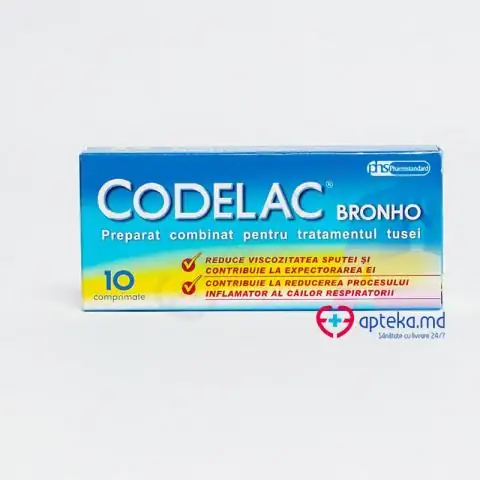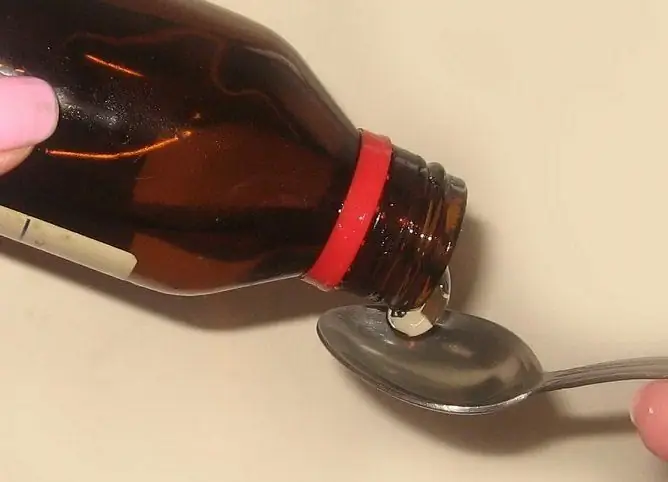- Author Rachel Wainwright [email protected].
- Public 2023-12-15 07:39.
- Last modified 2025-11-02 20:14.
Bromhexine-Akrikhin
Bromhexin-Akrikhin: instructions for use and reviews
- 1. Release form and composition
- 2. Pharmacological properties
- 3. Indications for use
- 4. Contraindications
- 5. Method of application and dosage
- 6. Side effects
- 7. Overdose
- 8. Special instructions
- 9. Application during pregnancy and lactation
- 10. Use in childhood
- 11. In case of impaired renal function
- 12. For violations of liver function
- 13. Drug interactions
- 14. Analogs
- 15. Terms and conditions of storage
- 16. Terms of dispensing from pharmacies
- 17. Reviews
- 18. Price in pharmacies
Latin name: Bromhexine-Akrichin
ATX code: R05CB02
Active ingredient: bromhexine (bromhexine)
Manufacturer: JSC "Akrikhin" (Russia)
Description and photo updated: 22.11.2018
Prices in pharmacies: from 39 rubles.
Buy

Bromhexine-Akrikhin is an expectorant mucolytic drug.
Release form and composition
Dosage forms of the drug:
- syrup: a clear liquid from light yellow to yellow with a greenish tinge, with a characteristic odor (100 ml in a bottle, in a cardboard box 1 bottle with a measuring spoon or glass);
- tablets: flat-cylindrical, white, yellowish or grayish tint is allowed, with a chamfer [10 tablets in a blister strip, in a cardboard box 2 (for 8 mg tablets) or 5 (for 4 mg tablets) packages].
Composition of 100 ml of Bromhexin-Akrikhin syrup:
- active substance: bromhexine hydrochloride (in terms of 100% substance) - 80 mg;
- auxiliary components: propylene glycol, benzoic acid, sorbitol, levomenthol, citric acid monohydrate, sodium saccharinate dihydrate, vanillin, dye, orange flavor, purified water.
Composition of 1 tablet Bromhexin-Akrikhin:
- active substance: bromhexine hydrochloride (in terms of 100% substance) - 4 or 8 mg;
- auxiliary components: lactose monohydrate, microcrystalline cellulose, croscarmellose sodium, colloidal silicon dioxide, calcium stearate.
Pharmacological properties
Pharmacodynamics
Bromhexine is a mucolytic (secretolytic) agent, has an expectorant and weak antitussive effects. Reduces the viscosity of sputum due to depolymerization of mucoprotein and mucopolysaccharide fibers and an increase in the serous component in bronchial secretions. In addition, the drug activates the ciliated epithelium, increases the volume of sputum and improves its discharge. It has a stimulating effect on endogenous surfactant (increases its production), which is necessary for the stability of alveolar cells during respiration. The effect of the drug develops on days 2-5 of therapy.
Pharmacokinetics
When bromhexine is taken orally within 30 minutes, it is absorbed almost completely (99%). About 80% of the dose taken is metabolized by the first pass effect through the liver. Bromhexine crosses the placental and blood-brain barriers. After demethylation and oxidation of bromhexine, the active metabolite ambroxol is formed in the liver. The substance is characterized by slow reverse diffusion from tissues, due to which its half-life is 15 hours. It is excreted by the kidneys. Chronic renal failure can interfere with the elimination process. With repeated administration of the drug, there is a risk of its cumulation.
Indications for use
Diseases accompanied by difficulty in the discharge of viscous sputum:
- bronchitis (of various etiology, including with bronchiectasis);
- tracheobronchitis;
- bronchial asthma;
- pulmonary tuberculosis;
- pneumonia;
- cystic fibrosis;
- preoperative period and carrying out diagnostic and therapeutic intrabronchial manipulations (for sanitation of the bronchial tree);
- postoperative period (to prevent the accumulation of thick viscous sputum in the bronchi).
Contraindications
Absolute contraindications:
- peptic stomach ulcer (syrup);
- exacerbation of stomach ulcer (tablets);
- lactase deficiency, lactose intolerance, glucose-galactose malabsorption (tablets);
- age up to 6 years (tablets);
- I trimester of pregnancy, lactation period;
- increased sensitivity to the components of the drug.
Relative contraindications:
- diseases of the bronchi with excessive accumulation of secretions;
- renal or hepatic impairment;
- a history of gastric bleeding.
Instructions for use Bromhexin-Akrikhin: method and dosage
Bromhexine-Akrikhin syrup and tablets are taken orally, regardless of food intake. The recommended duration of therapy is 4-28 days.
Syrup
Recommended dosage:
- children under 2 years old: 2.5 ml 3 times a day;
- children 2-6 years old: 2.5-5 ml 3 times a day;
- children 6-14 years old: 5-10 ml 3 times a day;
- adolescents over 14 years old and adults: 10-20 ml 3-4 times a day.
Pills
Recommended dosage:
- children 6-14 years old: 8 mg 3 times a day;
- adolescents over 14 years old and adults: 8-16 mg 3-4 times a day.
Side effects
The following undesirable effects are possible: dyspepsia, nausea, vomiting, allergic reactions, exacerbation of stomach and duodenal ulcers, headache, dizziness, increased activity of hepatic transaminases.
These side effects are the reason for discontinuation of the drug.
Overdose
Symptoms of an overdose of Bromhexine-Akrikhin: diarrhea, nausea, vomiting.
Recommended treatment: artificial vomiting and gastric lavage within 60-120 minutes after taking the drug.
special instructions
Taking an additional amount of liquid improves the expectorant properties of the drug.
When treating children, it is recommended, in addition to taking the drug, to use postural drainage or vibration massage of the chest to facilitate the removal of sputum from the bronchi.
Influence on the ability to drive vehicles and complex mechanisms
During the period of application of the drug Bromhexin-Akrikhin, care should be taken when driving vehicles and other complex mechanisms that require the speed of psychomotor reactions.
Application during pregnancy and lactation
According to the instructions, Bromhexine-Akrikhin is contraindicated in the first trimester of pregnancy and during lactation.
Pediatric use
In children under 6 years of age, Bromhexin-Akrikhin syrup should be used.
With impaired renal function
Patients with impaired renal function should use the drug with caution due to the risk of impaired elimination.
For violations of liver function
Patients with hepatic impairment are advised to be careful when taking Bromhexine-Akrikhin.
Drug interactions
Co-administration with drugs that suppress the cough center is contraindicated, due to the risk of sputum accumulation in the respiratory tract. Also, bromhexine is incompatible with alkaline solutions.
When taken together with antibiotics and sulfonamides, bromhexine promotes their penetration into the bronchial secretions in the first 4-5 days of their intake.
Analogs
Bromhexine-Akrikhin analogs are Bromhexine, Solvin.
Terms and conditions of storage
Store in a dry place, away from light, at a temperature not exceeding 25 ° C. Keep out of the reach of children.
The shelf life of the syrup is 4 years, of the tablets - 2 years.
Terms of dispensing from pharmacies
Available without a prescription.
Reviews about Bromhexine-Akrikhin
Reviews of Bromhexine-Akrikhin prove the effectiveness of the drug in the treatment of both children and adults. In addition, among the advantages of a drug, its affordable price is often mentioned.
Price for Bromhexine-Akrikhin in pharmacies
The approximate price for Bromhexine-Akrikhin is:
- syrup, 100 ml - 150 rubles;
- tablets 4 mg, 50 pcs. - 70 rubles, tablets 8 mg, 20 pcs. - 21 rubles.
Bromhexine-Akrikhin: prices in online pharmacies
|
Drug name Price Pharmacy |
|
Bromhexine-Akrikhin 8 mg tablets 20 pcs. RUB 39 Buy |
|
Bromhexin-Akrikhin 4 mg tablets 50 pcs. RUB 65 Buy |
|
Bromhexine-Akrikhin 4 mg / 5 ml syrup 100 ml 1 pc. 154 RUB Buy |
|
Bromhexine-Akrikhin syrup 4mg / 5ml 100ml 201 RUB Buy |

Anna Kozlova Medical journalist About the author
Education: Rostov State Medical University, specialty "General Medicine".
Information about the drug is generalized, provided for informational purposes only and does not replace the official instructions. Self-medication is hazardous to health!






